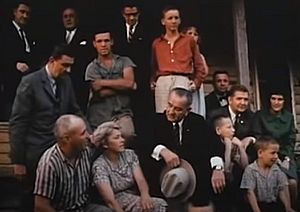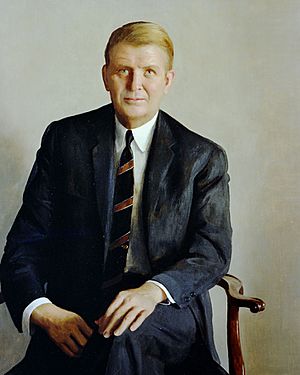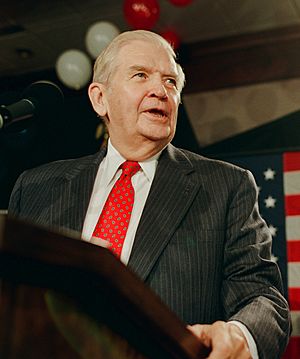Terry Sanford facts for kids
Quick facts for kids
Terry Sanford
|
|
|---|---|
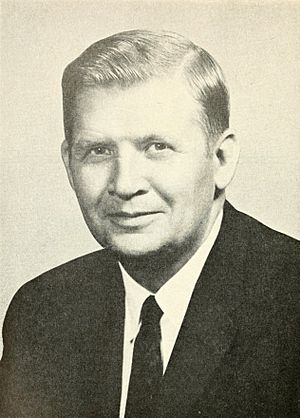
Sanford in 1961
|
|
| United States Senator from North Carolina |
|
| In office December 10, 1986 – January 3, 1993 |
|
| Preceded by | Jim Broyhill |
| Succeeded by | Lauch Faircloth |
| 6th President of Duke University | |
| In office April 2, 1970 – July 4, 1985 |
|
| Preceded by | Douglas Knight |
| Succeeded by | H. Keith H. Brodie |
| 65th Governor of North Carolina | |
| In office January 5, 1961 – January 8, 1965 |
|
| Lieutenant | Harvey Cloyd Philpott |
| Preceded by | Luther H. Hodges |
| Succeeded by | Dan K. Moore |
| Member of the North Carolina Senate from the 10th district |
|
| In office January 7, 1953 – January 1955 Serving with James Bridger
|
|
| Preceded by | Bunn Frink Junius Powell |
| Succeeded by | Ray Walton Arthur Williamson |
| Personal details | |
| Born |
James Terry Sanford
August 20, 1917 Laurinburg, North Carolina, U.S. |
| Died | April 18, 1998 (aged 80) Durham, North Carolina, U.S. |
| Resting place | Duke Chapel |
| Political party | Democratic |
| Spouse |
Margaret Knight
(m. 1942) |
| Education | University of North Carolina, Chapel Hill (AB, LLB) |
| Signature | |
| Military service | |
| Allegiance | |
| Branch/service | |
| Years of service | 1942–1945 1948–1960 |
| Rank | |
| Unit | 517th Parachute Infantry Regiment North Carolina Army National Guard |
| Battles/wars | |
| Awards | |
James Terry Sanford (August 20, 1917 – April 18, 1998) was an American lawyer and politician from North Carolina. He was a member of the Democratic Party. Sanford served as the 65th Governor of North Carolina from 1961 to 1965. He also ran for U.S. president twice in the 1970s. Later, he served as a U.S. senator from 1986 to 1993.
Terry Sanford strongly supported public education. As governor, he brought in many new programs and changes to North Carolina's schools and colleges. From 1970 to 1985, Sanford was the president of Duke University. He was born in Laurinburg, North Carolina. After college, he worked as a Federal Bureau of Investigation special agent. During World War II, he joined the United States Army and fought in Europe. After the war, he became a lawyer and got involved in politics.
Contents
- Terry Sanford: A Leader for North Carolina
- Terry Sanford as Governor
- After Being Governor
- Leading Duke University
- Serving in the U.S. Senate
- Later Years and Legacy
- Images for kids
Terry Sanford: A Leader for North Carolina
Growing Up in North Carolina
James Terry Sanford was born on August 20, 1917, in Laurinburg, North Carolina. He was the second of five children. His father ran a hardware store, and his mother was a teacher. They lived a comfortable middle-class life. During the Great Depression, his father's store closed. The family faced tough times, but they always had food. Terry and his brother did odd jobs to earn money. They raised chickens, sold vegetables, and delivered newspapers.
Education and Early Career
Sanford graduated from high school in 1934. He first went to Presbyterian Junior College. He found it wasn't a good fit and left after one semester. In 1935, he enrolled at the University of North Carolina at Chapel Hill. He worked many jobs to pay for school. He decided to study political science. After graduating in 1939, he went to law school at the University of North Carolina School of Law.
While in law school, he became interested in student politics. He won a seat on the student legislative council. In 1941, he started working at UNC-Chapel Hill's Institute of Government. As World War II began, many students joined the military. Sanford tried to join the United States Army Air Corps but was told his eyesight wasn't good enough. He also tried to join the United States Marine Corps and the Navy.
Serving His Country
FBI and Military Service
With help from a professor, Sanford joined the Federal Bureau of Investigation (FBI) in December 1941. He worked as a special agent in Ohio and Missouri. On July 4, 1942, he married Margaret Rose Knight. They later had two children, Terry Jr. and Elizabeth.
Sanford still wanted to join the military. He was especially interested in the new paratrooper units. He left the FBI and joined the United States Army on December 7, 1942. He trained in Georgia and was assigned to the 501st Infantry Regiment. He quickly moved up in rank. In 1943, he became a second lieutenant. He led a platoon in the 517th Parachute Infantry Regiment.
Fighting in World War II
Sanford's unit went to Italy in May 1944. He first fought German forces in June. In August, he parachuted into southern France during Operation Dragoon. By December, he was a first lieutenant. That month, his unit fought in the Battle of the Bulge in Belgium. During a fight, Sanford captured a German major. In January 1945, he was wounded in his hand by shrapnel. For his bravery and injuries, he received the Bronze Star and the Purple Heart.
Starting a Law Career
After the war, Sanford finished law school and became a lawyer in 1946. He worked as an assistant director at the Institute of Government until 1948. He then decided to become a lawyer in Fayetteville. He wanted to become a leader in the community. He opened his own law firm. From 1948 to 1960, Sanford also served as a company commander in the North Carolina Army National Guard.
Stepping into Politics
Early Political Steps
In 1949, Sanford became president of the North Carolina Young Democratic Clubs. He supported W. Kerr Scott in the 1948 governor's race. When Scott became governor, he appointed Sanford to a position.
In 1950, Sanford supported Frank Porter Graham for a U.S. Senate seat. The election became very focused on race. Sanford learned a lot from this campaign. He realized the importance of staying on the offensive in political debates.
Serving in the State Senate
In 1952, Sanford ran for a seat in the North Carolina Senate. He won easily and served one term from 1953 to 1955. He decided not to run for a second term. He worked on committees like Judiciary and Education. He found the job a bit boring but built good relationships with political journalists.
Helping Scott's Senate Campaign
In 1953, Sanford became the campaign manager for former Governor Kerr Scott, who was running for the U.S. Senate. Sanford helped Scott prepare speeches. He also helped Scott deal with racial issues after the Brown v. Board of Education decision, which called for desegregation in schools. Sanford helped expose a dirty trick by Scott's opponent, which helped Scott win the election.
Terry Sanford as Governor
Running for Governor in 1960
Sanford started preparing for his governor's race in 1959. On February 4, 1960, he announced his candidacy. His main goals were to improve education and grow North Carolina's economy. Other candidates included a state attorney general and a law professor, I. Beverly Lake, Sr.. Lake focused on keeping racial segregation, which worried Sanford. Sanford wanted to avoid making race the main topic.
Sanford won the first primary election. He then faced Lake in a runoff. Lake criticized Sanford's economic plans and said he would fight against integration. Sanford responded strongly. He said Lake was stirring up racial issues and would make things worse. He also said he knew how to handle racial situations better than a "theoretical college professor." Sanford emphasized that quality education was more important than racial matters.
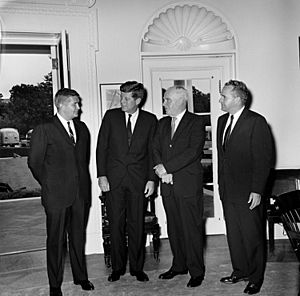
Sanford had a strong campaign team. He used media consultants and TV ads, which was new for North Carolina governor candidates. He was seen as a progressive but tried not to seem too liberal on race. Business leaders supported him because they feared Lake's views would hurt the state's economy. Sanford won the runoff election by a large margin.
Before the general election, Sanford supported John F. Kennedy for president. This angered some of his own supporters. Sanford then faced Republican Robert L. Gavin. Gavin called Sanford a tool of national liberals. Sanford campaigned hard for himself and Kennedy. In November 1960, both Kennedy and Sanford won their elections. Sanford became governor on January 5, 1961. He was the youngest governor in North Carolina since Charles B. Aycock.
Boosting Education in North Carolina
In 1960, North Carolina spent much less on public schools than other states. Teachers earned low salaries, and classrooms were crowded. Sanford believed that better education would lead to higher wages for everyone. In his first speech as governor, he said, "If it takes more taxes to give our children this quality education, we must face that fact."
The Quality Education Program
Sanford's main education plan was the Quality Education Program. It aimed to increase teacher pay by 22 percent. It also wanted to give schools 33 percent more money for supplies and double funds for school libraries. To pay for this, Sanford proposed removing sales tax exemptions on food and prescription drugs. This was a controversial idea. Many state officials were against raising taxes.
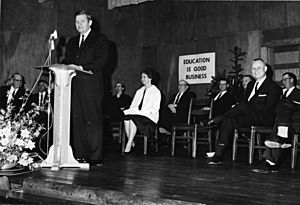
Sanford traveled across the state to promote his plan. He argued that North Carolina was falling behind in education. He also met with state lawmakers, inviting them to breakfast and visiting them. He offered political favors for support. His efforts worked, and the state legislature passed his program and the new taxes.
North Carolina's teacher salaries and school spending quickly improved in national rankings. Sanford's success gained national attention. However, the tax increase was not popular in North Carolina. In November 1961, voters rejected state bond proposals, which was the first time since 1924. Sanford was disappointed but kept pushing forward.
Expanding Higher Education
In 1961, Sanford created a commission to study education beyond high school. This led to the creation of a statewide system of community colleges in 1963. He also convinced lawmakers to create the North Carolina School of the Arts. This school was meant to keep talented students in music, drama, and dance in their home state.
Sanford's policies nearly doubled North Carolina's spending on public schools. He also hired 2,800 more teachers. He worked hard to make sure the state's education funding kept up with other states.
Fighting Poverty with the North Carolina Fund
Sanford felt he had used most of his political power on education. So, he looked for private money to fight poverty. He believed that much of North Carolina's poverty was due to racial unfairness. He wanted any anti-poverty plan to help both black and white people.
In 1962, he met with leaders from the Ford Foundation, a large charity. He convinced them to fund an anti-poverty project in North Carolina. He also got support from other state foundations. In July 1963, the Ford Foundation gave $7 million. On July 18, Sanford and other leaders created the North Carolina Fund.
The Fund's goals were to fight poverty and promote racial equality. Since it was privately funded, it could be more flexible. The organization had a staff of both black and white people, which was unusual then. The Fund created programs like Head Start for young children. It also supported job training courses. These programs were studied by President Johnson's administration for his "war on poverty" efforts. The North Carolina Fund stopped operating in 1969.
Improving Race Relations and Civil Rights
When Sanford became governor, schools and public places were still segregated in North Carolina. He believed racism was wrong. He initially wanted to avoid dealing with racial issues directly. However, he soon felt he had to act.
Appointing Black Leaders
Sanford began appointing black professionals to state offices. He placed over three dozen black individuals on state boards and committees. He also talked with black community leaders about civil rights. In 1961, he decided to integrate North Carolina's state parks. Sanford believed in using persuasion and kindness to bring about social change. He hoped that people's "basic goodness" would win out.
Protecting Civil Rights Demonstrators
In May 1961, Freedom Riders came to North Carolina to protest segregation on buses. Sanford ordered the State Highway Patrol to protect them. He always used state police to keep order at civil rights demonstrations. He never used them to break up protests. He said, "It was up to us to keep the order and let them demonstrate, which was constitutional."
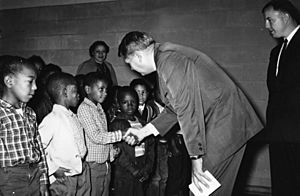
Sanford's views on civil rights changed as he visited schools. He felt uncomfortable telling black students about future opportunities. He knew those opportunities often didn't exist for them. He also saw that many older black people were supporting student protests.
Calling for Fair Employment
In October 1962, Sanford said that poverty was made worse by the lack of economic chances for black people. He called for an end to unfair hiring practices. On January 18, 1963, he became the first Southern governor to call for an end to racial discrimination in jobs. He said, "The time has come for American citizens to give up this reluctance, to quit unfair discrimination."
That same day, Sanford created the Good Neighbor Council. This group aimed to encourage fair hiring practices. It also encouraged young people to prepare for good jobs. However, the council had no power to enforce its ideas, so its impact was small.
Facing Protests
Many young black people felt Sanford wasn't doing enough. In May 1963, 500 black student protesters gathered at the Governor's Mansion. Sanford told them to come to his office with their requests. When a student said he should already know their problems, Sanford replied, "I'm not dictator, son. You're in a democracy." The students booed him.
Later, 400 black students were arrested in Greensboro for protesting segregation. Sanford arranged for their release. In June, he met with 150 black leaders. He told them that mass protests would not solve problems. He said their real enemy was the old system of a "cotton economy" that led to poverty. He believed education was the way to fight this enemy.
In January 1964, civil rights groups demanded that Chapel Hill fully desegregate. Sanford said he would support local officials against this demand. He felt he had been "pushed around long enough." Protests continued, leading to arrests. Sanford tried to help find a solution.
End of His Term as Governor
President Kennedy was assassinated in November 1963. Sanford had been trying to get a large environmental research center located in North Carolina. After Kennedy's death, President Johnson agreed to place the $25 million facility at the Research Triangle Park.
Sanford's actions on race made some white people in North Carolina unhappy. He could not run for governor again in 1964. His chosen successor lost the Democratic primary. Sanford felt some civil rights leaders had hurt his party by continuing protests.
Before leaving office in January 1965, Sanford worked to protect his projects. He moved a student internship program to UNC's Institute of Government. He also urged studies on affordable housing. He was succeeded by Dan K. Moore on January 8, 1965.
After Being Governor
After his term, Sanford was not very popular in North Carolina. But over time, people's opinions of him improved. He opened a new law firm in Raleigh. In 1966, he wrote a book about his time as governor called But What About the People?. The next year, he wrote Storm Over the States, about the role of state governments.
In 1968, Sanford considered running for U.S. Senate but decided against it. He managed President Johnson's campaign for a short time. He also helped Vice President Hubert Humphrey's presidential campaign. Humphrey lost to Republican Richard Nixon.
Leading Duke University
Becoming University President

In 1969, Duke University was having problems with student protests. The university president resigned. Sanford was chosen to be the new president. He started the job on April 2, 1970. One of his first actions was to remove a limit on Jewish student enrollment.
Improving Duke's Finances
Sanford wanted to make Duke a better school. The university had money problems and a small endowment (money set aside for the school). He worked to get more donations. He encouraged more students from North Carolina and wealthy families to enroll. He also personally reviewed applications from children of potential donors.
He asked the baseball coach, Tom Butters, to help with fundraising. He also reached out to Duke alumni for financial support. By the time he left, annual donations from alumni had grown from $750,000 to almost $6 million. The school's endowment grew from $80 million to $200 million.
Connecting with Students
Students were often suspicious of university leaders. Sanford tried to meet their needs. He spoke out against the Vietnam War to calm student protests. After the Kent State shootings in May 1970, Duke students planned protests. Sanford refused to call the police. He talked with the students and encouraged them to contact the government.
He wanted students to be more involved in running the university. He hired students as assistants in his office. He also held social gatherings for new students at his home, called "Tea with Terry." He helped get a student representative on the university's board of trustees. Students were surprised by his open and helpful style.
Regional Leadership and Public Policy
In the early 1970s, new "New South" governors were elected. They focused on government reform and avoided racial talk. Sanford suggested that Southern states work together. He helped create the Southern Growth Policies Board in 1971. This group aimed to coordinate growth and economic development in the South.
In 1971, Sanford also brought Joel Fleischman to Duke. Fleischman created the Institute of Policy Studies and Public Affairs in January 1972. This institute focused on public policy issues.
Nixon Presidential Library Idea
In 1981, Sanford thought about bringing Nixon's presidential library to Duke. He believed it would help the university's reputation. He discussed it with Nixon, who liked the idea. However, many professors at Duke were against it. They worried that Nixon's controversial past would harm the university. They also wanted the library to be a research center, not just a monument. Nixon eventually decided against Duke and built his library in California.
Sanford had planned to retire in 1982 but stayed longer. He officially resigned on July 4, 1985.
Presidential Campaigns While at Duke

Sanford said he wouldn't campaign for president but wouldn't refuse the job. In January 1972, Duke students asked him to run for the Democratic nomination. Sanford felt the other candidates were weak. He decided to run, hoping to challenge George Wallace, a segregationist governor. Sanford believed Wallace was a "pure hypocrite" who used race to gain votes.
Sanford announced his candidacy on March 8, 1972. He planned to stay at Duke and campaign on weekends. He focused on issues like ending tax loopholes for the rich, controlling food prices, and supporting equal rights for women. Wallace won the North Carolina primary. Sanford finished second. He continued his campaign but only got a small number of delegate votes at the Democratic convention.
In 1974, Sanford began preparing for another run for president in 1976. He announced his candidacy on June 1, 1975. He balanced campaigning with his duties as Duke president. He had to withdraw from the primaries in January 1976 due to a heart issue. His campaign left him almost bankrupt. After this, he focused on running the university. In 1985, he ran for chairman of the Democratic National Committee but lost.
Serving in the U.S. Senate
Running for Senate in 1986
In late 1985, Sanford thought about running for the U.S. Senate. He announced his candidacy in January 1986. He won the Democratic primary easily. His opponent in the general election was Republican Jim Broyhill. Broyhill was temporarily appointed to the Senate seat after the previous senator died.
Sanford highlighted his achievements as governor and his military service. Critics focused on his support for minorities, his education funding (which involved tax increases), and his anti-poverty efforts. Sanford criticized Broyhill for not supporting education. He won the election by about 60,000 votes. He was sworn into office on December 10, 1986.
His Time in the Senate
Sanford found the Senate different from executive roles. He felt it was hard to get things done. He served on several important committees, including Ethics, Budget, Banking, and Foreign Relations. He often presided over Senate sessions. He usually worked long hours and returned to Durham on weekends.
Central American Recovery Efforts
Sanford criticized President Reagan's policy in Nicaragua. He wanted a different solution, like the Marshall Plan. In February 1986, he traveled to Central America to study the issue. He proposed creating a multinational group to plan economic recovery after the conflict. This idea was well-received.
Sanford announced the creation of the International Commission for Central American Recovery and Development. This group, often called the "Sanford Commission," aimed to create a plan for regional development. Sanford secured private funding for its work. The commission's report in 1989 recommended actions for human rights and economic needs. Sanford believed the commission's work helped end the conflict.
Views on Politics and Policy
Sanford kept a journal during his Senate term. He often wrote about his frustration with how the Senate worked. He disliked how seniority seemed more important than good ideas. He also saw more political fighting and less willingness to compromise. He strongly disagreed with Senator Jesse Helms, calling his service "of zero value to North Carolina."
Sanford worried about the growing government debt. He proposed an "Honest Budget Bill" to balance the budget and increase revenue. He also spoke against the nomination of Robert Bork to the Supreme Court. Sanford believed Bork was more interested in his own opinions than fair legal judgment.
Sanford supported Al Gore for president in 1988. He later backed Michael Dukakis. He worried that the Democratic Party was seen as "the black man's party," losing support from moderate white voters.

When the Supreme Court ruled that burning a United States Flag was a form of protest, some politicians proposed a Flag Desecration Amendment. Sanford thought this was a "demagogic" idea. He believed it went against the ideals of political freedom in the Bill of Rights. On October 17, 1989, he gave a speech against the amendment. He said it would limit the right to protest. The amendment did not pass.
By 1990, Sanford doubted if he should run for reelection. He felt his work in the Senate was "marginal." He had a more liberal voting record than other Southern Democrats. He also criticized American involvement in the Gulf War, preferring sanctions. His friend Lauch Faircloth switched to the Republican party and planned to challenge him. Sanford decided to run for reelection.
The 1992 Reelection Campaign
Sanford announced his reelection campaign on December 2, 1991. He faced no opposition in the Democratic primary. Faircloth won the Republican primary. Both promised to focus on issues. In June 1992, Sanford became ill with a heart valve infection. This delayed his campaigning.
Faircloth attacked Sanford as being too connected to special interests and supporting big government and higher taxes. Sanford called Faircloth a conservative hard-liner. In October, Sanford had surgery for his heart infection. This kept him from campaigning. Faircloth questioned his health and called him a Washington insider.
On November 3, 1992, Faircloth won the election by 100,000 votes. However, Bill Clinton won the presidency, and Jim Hunt was reelected Governor of North Carolina. Sanford celebrated the overall Democratic victories.
Later Years and Legacy
After leaving the Senate, Sanford taught a course on state government at Duke University. He also formed a law firm with former North Carolina governor James Holshouser. Sanford finished his last book, Outlive Your Enemies: Grow Old Gracefully, about aging and health. He also started writing a novel. He stayed in touch with politicians, including President Bill Clinton.
In December 1997, doctors found cancer in his esophagus and liver. It was inoperable. Terry Sanford died on April 18, 1998, at his home. His funeral was held at Duke Chapel. Many important political figures attended. He was buried in the chapel's crypt.
Sanford is remembered as a key figure of the "New South." He helped bring social modernization to the region. He is often called the "education governor" in North Carolina. His actions as governor are seen as the reason North Carolina focused so much on education reform. A 1981 Harvard University survey named him one of the 10 best governors of the 20th century.
Political scientist Tom Eamon called Sanford "North Carolina's most celebrated liberal politician." Sanford was a role model for many Southern governors, including Jim Hunt and Bill Clinton. When he died, President Clinton said, "His work and his influence literally changed the face and future of the South."
Duke University renamed its public policy institute the Sanford School of Public Policy in his honor. Terry Sanford High School in Fayetteville was named after him in 1968. The Terry Sanford Federal Building and Courthouse in Raleigh was named in his honor in 1999.
Images for kids


